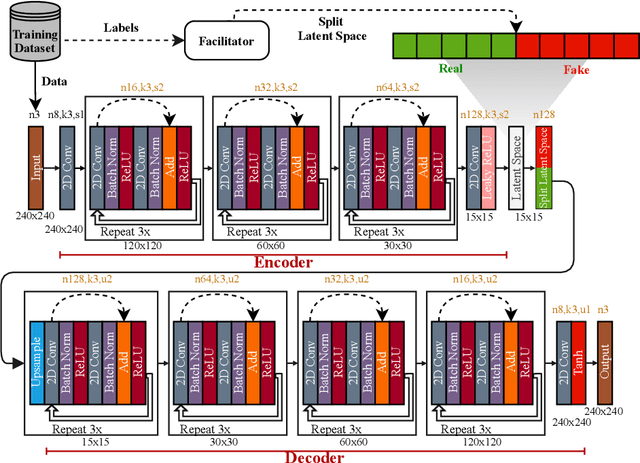Sangyup Lee
TAR: Generalized Forensic Framework to Detect Deepfakes using Weakly Supervised Learning
May 13, 2021



Abstract:Deepfakes have become a critical social problem, and detecting them is of utmost importance. Also, deepfake generation methods are advancing, and it is becoming harder to detect. While many deepfake detection models can detect different types of deepfakes separately, they perform poorly on generalizing the detection performance over multiple types of deepfake. This motivates us to develop a generalized model to detect different types of deepfakes. Therefore, in this work, we introduce a practical digital forensic tool to detect different types of deepfakes simultaneously and propose Transfer learning-based Autoencoder with Residuals (TAR). The ultimate goal of our work is to develop a unified model to detect various types of deepfake videos with high accuracy, with only a small number of training samples that can work well in real-world settings. We develop an autoencoder-based detection model with Residual blocks and sequentially perform transfer learning to detect different types of deepfakes simultaneously. Our approach achieves a much higher generalized detection performance than the state-of-the-art methods on the FaceForensics++ dataset. In addition, we evaluate our model on 200 real-world Deepfake-in-the-Wild (DW) videos of 50 celebrities available on the Internet and achieve 89.49% zero-shot accuracy, which is significantly higher than the best baseline model (gaining 10.77%), demonstrating and validating the practicability of our approach.
One Detector to Rule Them All: Towards a General Deepfake Attack Detection Framework
May 01, 2021



Abstract:Deep learning-based video manipulation methods have become widely accessible to the masses. With little to no effort, people can quickly learn how to generate deepfake (DF) videos. While deep learning-based detection methods have been proposed to identify specific types of DFs, their performance suffers for other types of deepfake methods, including real-world deepfakes, on which they are not sufficiently trained. In other words, most of the proposed deep learning-based detection methods lack transferability and generalizability. Beyond detecting a single type of DF from benchmark deepfake datasets, we focus on developing a generalized approach to detect multiple types of DFs, including deepfakes from unknown generation methods such as DeepFake-in-the-Wild (DFW) videos. To better cope with unknown and unseen deepfakes, we introduce a Convolutional LSTM-based Residual Network (CLRNet), which adopts a unique model training strategy and explores spatial as well as the temporal information in deepfakes. Through extensive experiments, we show that existing defense methods are not ready for real-world deployment. Whereas our defense method (CLRNet) achieves far better generalization when detecting various benchmark deepfake methods (97.57% on average). Furthermore, we evaluate our approach with a high-quality DeepFake-in-the-Wild dataset, collected from the Internet containing numerous videos and having more than 150,000 frames. Our CLRNet model demonstrated that it generalizes well against high-quality DFW videos by achieving 93.86% detection accuracy, outperforming existing state-of-the-art defense methods by a considerable margin.
A Convolutional LSTM based Residual Network for Deepfake Video Detection
Sep 16, 2020



Abstract:In recent years, deep learning-based video manipulation methods have become widely accessible to masses. With little to no effort, people can easily learn how to generate deepfake videos with only a few victims or target images. This creates a significant social problem for everyone whose photos are publicly available on the Internet, especially on social media websites. Several deep learning-based detection methods have been developed to identify these deepfakes. However, these methods lack generalizability, because they perform well only for a specific type of deepfake method. Therefore, those methods are not transferable to detect other deepfake methods. Also, they do not take advantage of the temporal information of the video. In this paper, we addressed these limitations. We developed a Convolutional LSTM based Residual Network (CLRNet), which takes a sequence of consecutive images as an input from a video to learn the temporal information that helps in detecting unnatural looking artifacts that are present between frames of deepfake videos. We also propose a transfer learning-based approach to generalize different deepfake methods. Through rigorous experimentations using the FaceForensics++ dataset, we showed that our method outperforms five of the previously proposed state-of-the-art deepfake detection methods by better generalizing at detecting different deepfake methods using the same model.
 Add to Chrome
Add to Chrome Add to Firefox
Add to Firefox Add to Edge
Add to Edge